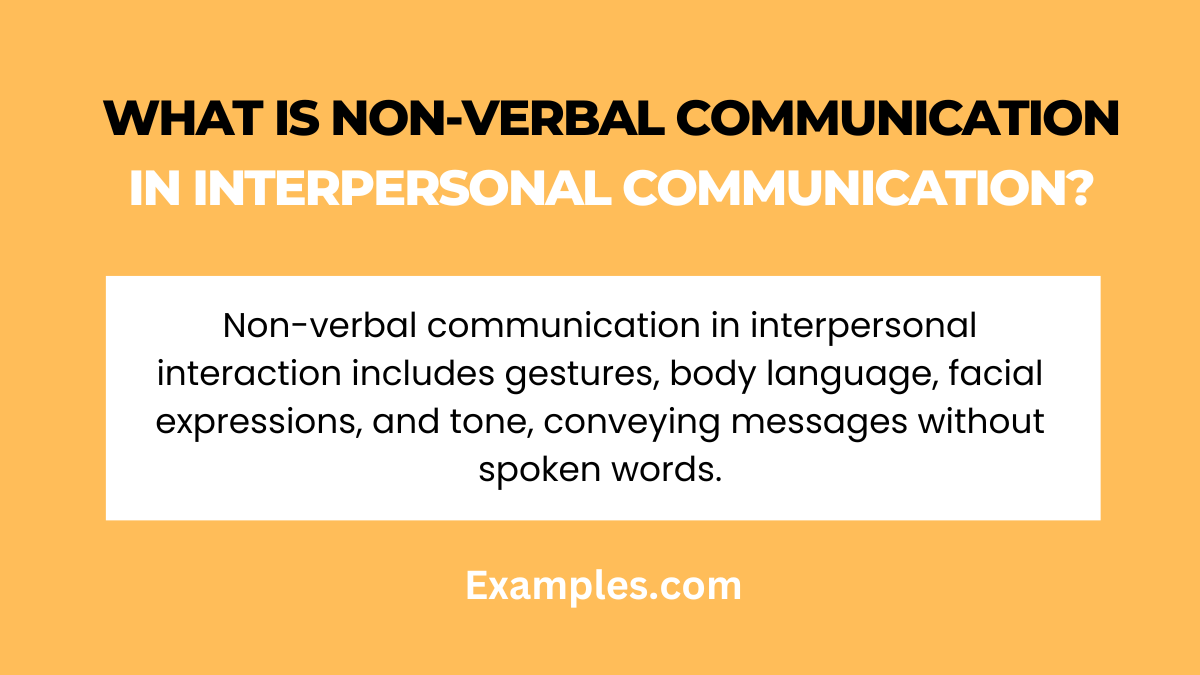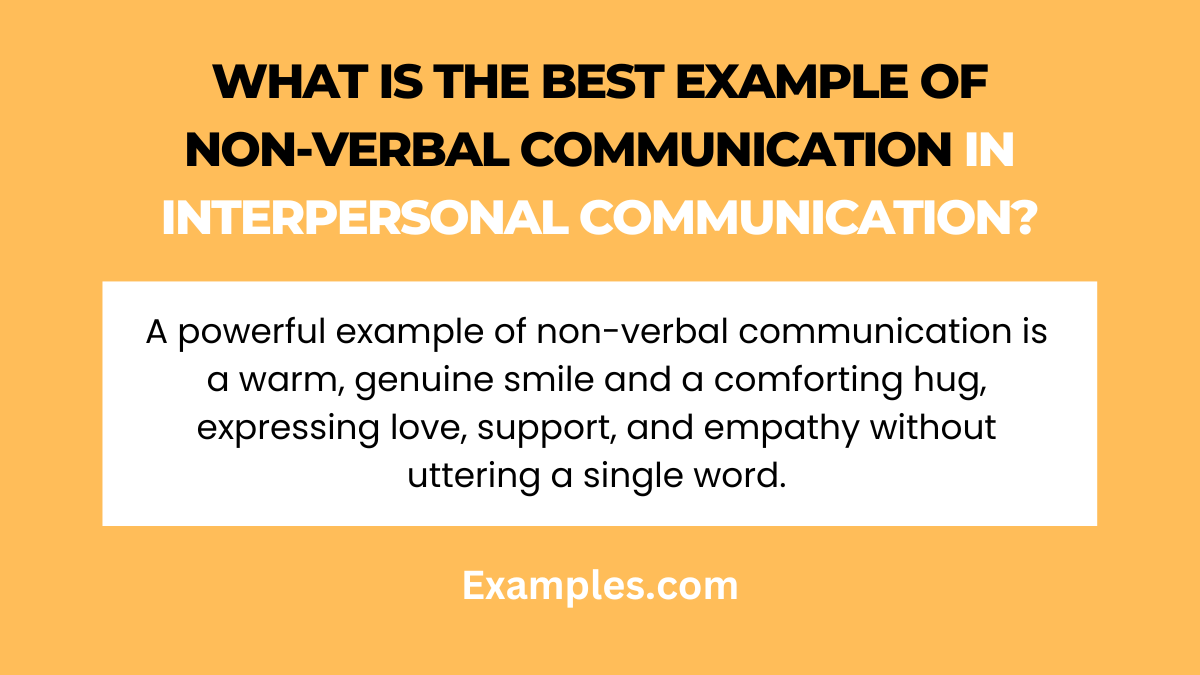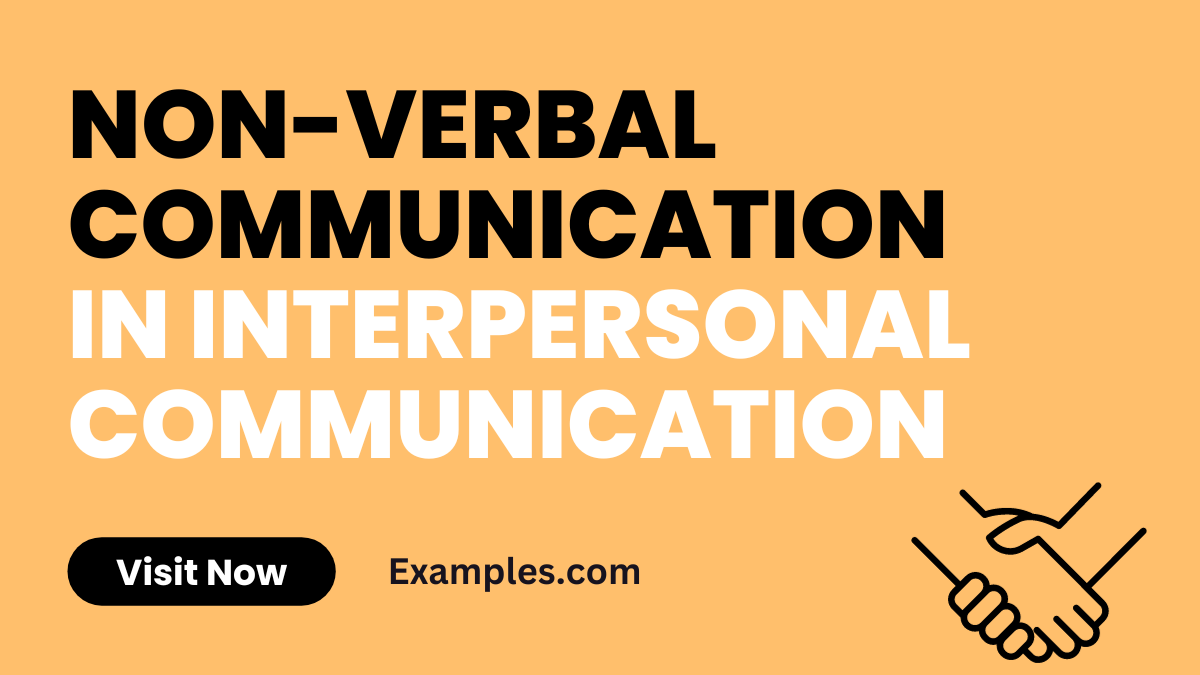14+ Non-Verbal Communication in Interpersonal Communication Examples
Non-Verbal Communication in Interpersonal Communication is an intricate part of our daily interactions, often speaking louder than words. This comprehensive guide provides insightful examples and practical tips, illustrating the nuances and impacts of non-verbal cues. From body language to facial expressions, understanding these unspoken elements is vital for effective and empathetic communication. Enhance your interpersonal skills by mastering the art of non-verbal communication, a key component in building stronger, more meaningful connections.
What is Non-Verbal Communication in Interpersonal Communication?

Non-Verbal Communication in Interpersonal Communication refers to the unspoken elements of interaction that complement, contradict, or substitute verbal messages. This encompasses body language, facial expressions, tone of voice, gestures, and posture. Understanding these non-verbal cues is crucial for effective communication, as they often convey more than words. Recognizing and interpreting these signals accurately can significantly enhance interpersonal relationships.
What is the Best Example of Non-Verbal Communication in Interpersonal Communication?

A prime example of Non-Verbal Communication in Interpersonal Communication is the use of eye contact. Maintaining appropriate eye contact during conversations demonstrates engagement, confidence, and sincerity. It helps establish trust and connection, conveying attentiveness and respect. On the other hand, avoiding eye contact might signal disinterest, discomfort, or dishonesty. Thus, mastering the balance of eye contact is essential for effective interpersonal communication.
15 Examples of Non-Verbal Communication in Interpersonal Communication
Non-Verbal Communication in interpersonal communication is a subtle yet powerful mode of conveying messages. It encompasses a range of behaviors and actions that, without words, express our intentions, emotions, and reactions. This article delves into 30 distinct non-verbal cues, each elucidating how physical gestures, facial expressions, and other forms of body language significantly impact interpersonal interactions. Understanding these cues enhances our ability to communicate effectively and empathetically in various social contexts.
- Smiling: Indicates friendliness and approachability. Use a genuine smile to create a positive atmosphere.
- Nodding: Shows understanding or agreement. Nod subtly to acknowledge what’s being said.
- Eye Contact: Demonstrates interest and honesty. Maintain appropriate eye contact to engage with others.
- Leaning In: Suggests interest and attentiveness. Lean in slightly to show you are actively listening.
- Mirroring Gestures: Builds rapport and empathy. Subtly mirror the other person’s gestures to establish a connection.
- Raised Eyebrows: Indicates surprise or curiosity. Raise your eyebrows briefly to show interest or surprise.
- Tilting Head: Shows engagement and thoughtfulness. Tilt your head slightly when listening intently.
- Open Hands: Signifies honesty and openness. Keep your hands open to show you have nothing to hide.
- Palms Down: Projects authority and certainty. Use palms-down gestures when giving instructions or stating facts.
- Crossing Legs Away from Someone: Can indicate disagreement or discomfort. Be mindful of your leg posture during conversations.
- Handshake Firmness: Reflects confidence and respect. A firm, not too strong, handshake is appropriate.
- Foot Tapping: Suggests impatience or nervousness. Keep feet still to show attentiveness.
- Avoiding or Excessive Touch: Indicates discomfort or over-familiarity. Gauge the comfort level of others before initiating physical contact.
- Closed Body Language (Crossed Arms/Legs): Implies defensiveness or disinterest. Adopt an open stance to seem more approachable.
- Excessive Nodding: May be interpreted as overeagerness or lack of confidence. Nod sparingly to convey understanding
How Important is Non-Verbal Communication in Interpersonal Communication?
Non-verbal communication plays a pivotal role in interpersonal communication, often conveying more than words can. Here are eight points detailing its importance:
- Conveys Emotional States: Non-verbal cues like facial expressions and body language often reveal true emotions, sometimes more accurately than verbal communication.
- Enhances Understanding: Gestures and expressions can add clarity and depth to verbal messages, aiding in better comprehension.
- Facilitates Connection: Effective non-verbal communication, such as eye contact and touch, can create a sense of empathy and connection between individuals.
- Regulates Conversations: Pauses, nods, and other non-verbal signals help regulate the flow of conversation, signaling when it’s someone’s turn to speak.
- Substitutes Verbal Communication: In situations where verbal communication is not possible, non-verbal cues become the primary mode of expressing thoughts and feelings.
- Reflects Cultural Differences: Non-verbal communication varies across cultures, emphasizing the need for cultural sensitivity and understanding in interpersonal interactions.
- Indicates Interpersonal Attitudes: Body posture and proximity can indicate one’s attitude towards others, such as openness or defensiveness.
- Enhances Persuasiveness: Effective use of non-verbal cues can enhance the persuasiveness of a verbal message, making communication more impactful.
Role of Non-Verbal Communication in Interpersonal Communication
The role of non-verbal communication in interpersonal interactions is multifaceted and vital. Here are eight key roles it plays:
- Complementing Verbal Messages: Non-verbal cues can add meaning and context to verbal communication, enriching the message conveyed.
- Contradicting Verbal Messages: At times, non-verbal signals can contradict what is being said, revealing hidden emotions or intentions.
- Establishing Relationship Dynamics: The use of space, touch, and body orientation helps establish the nature of relationships, whether formal, intimate, or distant.
- Influencing Social Interaction: Non-verbal cues can greatly influence the nature of social interactions, either positively or negatively.
- Conveying Personality Traits: Consistent non-verbal behaviors can give insights into an individual’s personality, such as confidence, anxiety, or openness.
- Facilitating Emotional Expression: Facial expressions, gestures, and postures are essential for expressing a wide range of emotions without verbal communication.
- Providing Feedback: Non-verbal responses like nodding or frowning provide immediate feedback in conversations, guiding the flow of interaction.
- Serving as a Form of Identity: Personal appearance and artifacts (like clothing or accessories) serve as forms of non-verbal communication, reflecting personal identity and social status.
Functions of Non-Verbal Communication in Interpersonal Communication
Non-verbal communication fulfills several key functions in interpersonal communication. Here are eight primary functions:
- Reinforcing Verbal Messages: Gestures or facial expressions can reinforce the spoken word, adding emphasis or clarity.
- Replacing Words: In situations where verbal communication is inadequate or unavailable, non-verbal cues can effectively convey messages.
- Regulating Conversations: Non-verbal signals like head nods or eye movements can regulate the flow of conversation, indicating when it’s appropriate to speak or listen.
- Creating Immediate Impact: Non-verbal cues often make the first impression and can have a lasting impact on interpersonal dynamics.
- Demonstrating Socio-cultural Norms: Many non-verbal behaviors are culturally specific, reflecting societal norms and values.
- Expressing Emotions: Non-verbal communication is crucial in expressing emotions that might be difficult to articulate verbally.
- Facilitating Memory and Recall: Visual non-verbal cues, like visual communication in presentations, can aid in memory and recall of information.
- Building Trust and Credibility: Consistent and appropriate non-verbal communication can build trust and enhance credibility in interpersonal interactions.
In conclusion, mastering non-verbal communication is essential for enhancing interpersonal interactions. This guide has explored various forms of non-verbal cues, emphasizing their significance in conveying emotions and intentions beyond words. Understanding and effectively utilizing these non-verbal signals, such as body language, facial expressions, and eye contact, can greatly improve communication and relationship building.



